Regions of China
| Regions of China | |
|---|---|
 | |
| Category | Administrative division |
| Location | Republic of China |
| Found in | Legal jurisdictions |
| Created | March 24, 2021 |
| Number | 15 |
| Government |
Provincial government (10) Autonomous provincial government (1) Parliamentary republic (4) |
| Republic of China |
 This article is part of the series: |
|
|
|
The Republic of China consists of 15 regions (Chinese: 地区, dìqū), which are also sometimes called federal states (联邦州, liánbāng zhōu) and are divided into three categories: ten provinces (省, shěng), one autonomous province (自治省, zìzhì shěng), and four republics (共和國, gònghéguó). The regions form the highest level administrative division of China, followed by the secondary level that consists of prefectures (府, fǔ), the tertiary level consisting of counties (縣, xiàn), and the lowest level, municipalities (including village, township, or city). The capital city Beijing is a unique prefecture-level municipality (the National Capital Region) that is directly administered by the central government of the Republic of China.
The current structure was codified into law and came into affect on March 24, 2021, following the passage of the National Administrative and Constitutional Reform Law by the Legislative Yuan, the parliament of the Chinese republic. Before that, since the dissolution of the People's Republic of China in 2000, the country was divided into 22 provinces, which itself was carried over from the previous system that existed since the 1960s under Landonism. In 2014 a 23rd province was added with the annexation of Rehe from Manchuria, which is still internationally recognized as part of Manchuria by most countries. The 2021 reform combined many of the existing provinces, reducing the number of the new regions to 15.
The provinces and the autonomous province follow a similar government structure as before the 2021 law was adopted, mainly with new rules to increase elections for offices as well as the power of local governments. Provinces are led by a governor and a provincial assembly. The republics are unique, created mainly in regions that are known for having large numbers of non-Han Chinese ethnic groups (including Mongolia, Qinghai, Tibet, and Xinjiang) and in theory are granted additional rights, while provinces mainly govern China proper. Each republic is government by a president and legislature, with the right to its own official languages, constitution, and national anthem. Many of their powers are still limited by the central government in practice, and republics are only slightly different than provincial governments.
Summary
| Summary of administrative divisions of China | ||||
|---|---|---|---|---|
| Primary | Secondary | Tertiary | Quaternary | |
| 10 provinces (省) 1 autonomous province (自治省) 4 republics (共和國) |
354 prefectures (府) | 3,182 counties (縣) | 47,034 municipalities (鄉) | |
Overview
| Federal regions of China | |||||||
|---|---|---|---|---|---|---|---|
| Flag | Region | Type | Capital | Pre-2021 provinces | Population | Map | |
 |
Guangxi | Province | Guangzhou | Guangdong, Guangxi | 256,894,132 | 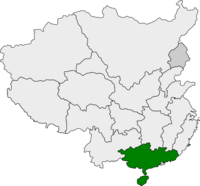
| |
 |
Huguang | Province | Wuhan | Hubei, Hunan | 225,237,300 | 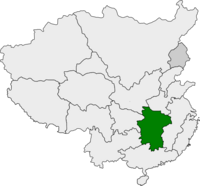
| |
 |
Liangjiang | Province | Shanghai | Jiangsu, Jiangxi, Anhui | 296,171,200 | 
| |
 |
Min-Zhe | Province | Fuzhou | Fujian, Zhejiang | 98,426,166 | 
| |
 |
Shaan-Gan | Province | Taiyuan | Shaanxi, Shanxi, Gansu | 200,575,254 | 
| |
 |
Sichuan | Province | Chongqing | Sichuan | 103,301,350 | 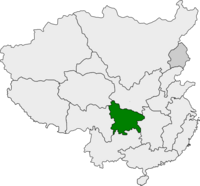
| |
 |
Yunnan | Province | Kunming | Yunnan, Guizhou | 101,938,239 | 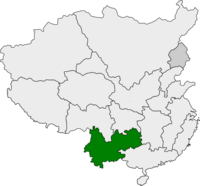
| |
 |
Zhili | Province | Beijing | Zhili | 130,793,100 | 
| |
 |
Zhongyuan | Province | Luoyang | Henan, Shandong | 203,026,891 | 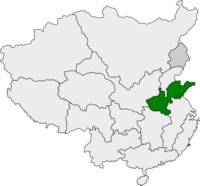
| |
 |
Xikang | Province | Xichang | eastern Tibet | 7,709,505 | 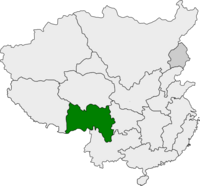
| |
 |
Rehe | Autonomous Province | Chengde | Rehe | 12,552,292 | 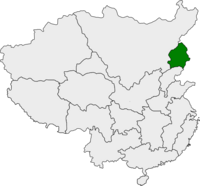
| |
 |
Mongolia | Republic | Urga | Inner Mongolia, Outer Mongolia | 42,418,020 | 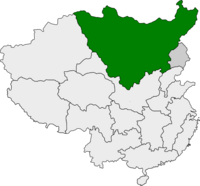
| |
 |
Qinghai | Republic | Qinghai | 18,712,111 | 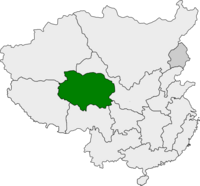
| ||
 |
Tibet | Republic | Lhasa | western Tibet | 2,930,065 | 
| |
 |
Xinjiang | Republic | Kashgar | Xinjiang | 29,813,040 | 
| |
